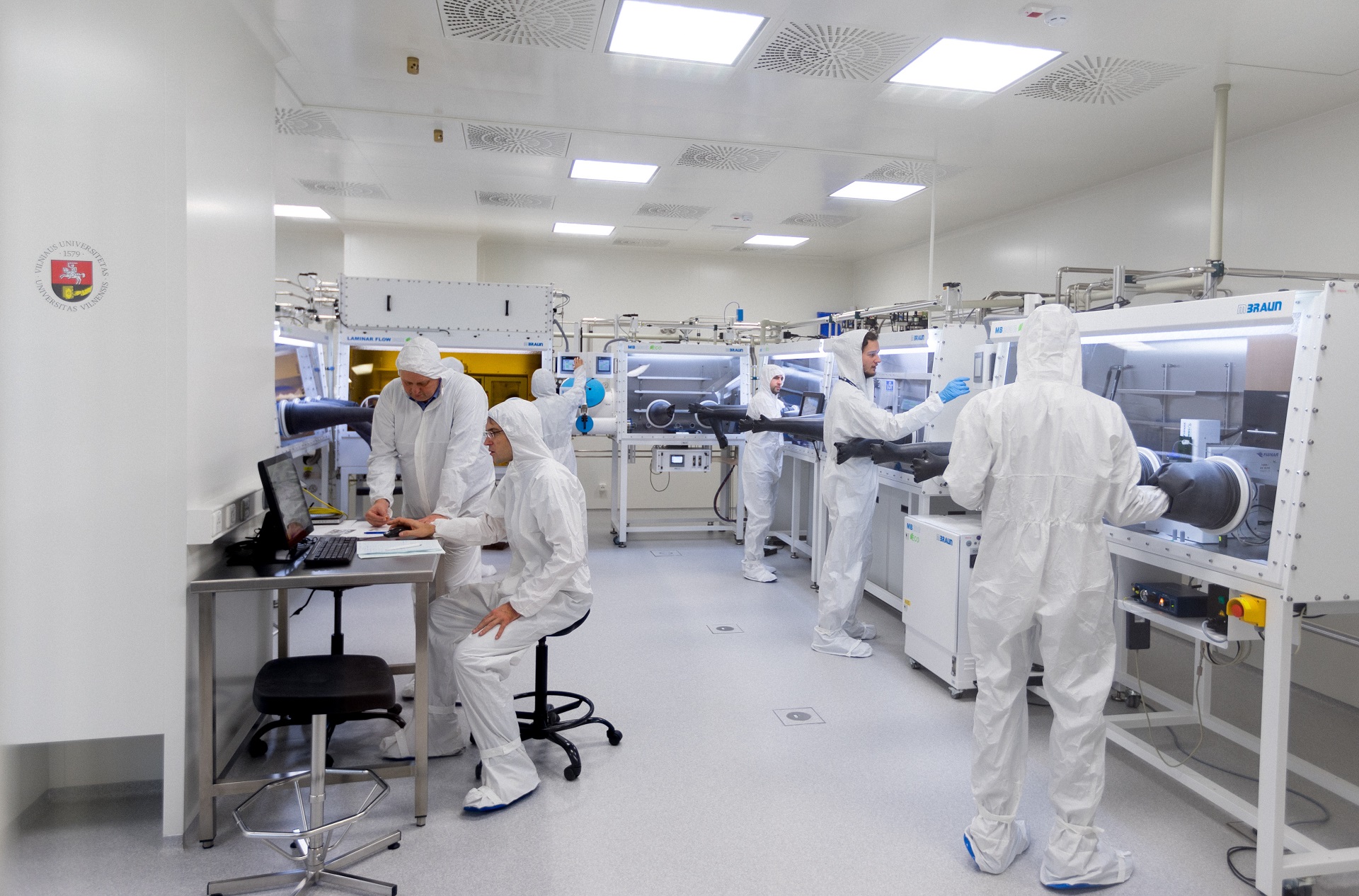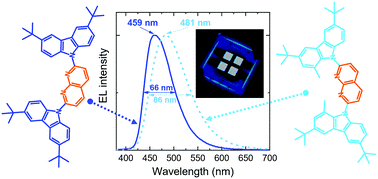New Approach of VU Scientists to Blue Light Opens up Wide Opportunities for Commercialization
 The Article “Realization of deep-blue TADF in sterically controlled naphthyridines for vacuum- and solution-processed OLEDs” published by scientists of the Institute of Photonics and Nanotechnologies and Faculty of Chemistry and Geosciences of Vilnius University (VU) has been recognised and included in the collection of the 50 most popular articles of the Journal of Materials Chemistry C of the Royal Society of Chemistry (RSC). Given that almost 2,000 scientific papers are published in the journal each year, to be included in the top 50 signifies the outstanding relevance of the VU scientists’ work.
The Article “Realization of deep-blue TADF in sterically controlled naphthyridines for vacuum- and solution-processed OLEDs” published by scientists of the Institute of Photonics and Nanotechnologies and Faculty of Chemistry and Geosciences of Vilnius University (VU) has been recognised and included in the collection of the 50 most popular articles of the Journal of Materials Chemistry C of the Royal Society of Chemistry (RSC). Given that almost 2,000 scientific papers are published in the journal each year, to be included in the top 50 signifies the outstanding relevance of the VU scientists’ work.
The article was prepared by VU physicists Gediminas Kreiza, Dovydas Banevičius, Justina Jovaišaitė, Saulius Juršėnas and Karolis Kazlauskas and VU chemists Tomas Javorskis, Vytenis Vaitkevičius and Edvinas Orentas. All authors unanimously agree that this is an extraordinary achievement.
“The journal publishes a couple of thousand science papers per year on a variety of interdisciplinary topics, wherein promising materials for optical and electronic devices are being introduced, and applications of these materials in various sensors, transistors, solar cells, LEDs and other devices are being demonstrated. It is a serious challenge not to drown in the sea of topics and to be noticed. To be ranked among the leaders clearly shows that the research area chosen by our group is indeed highly relevant and our work is very important for the scientific community,” Dr Kazlauskas said.
A long road towards high efficiency
The article is devoted to the third generation blue light-emitting organic compounds, also known as thermally activated delayed fluorescent (TADF) emitters.
From fundamental physics it is known that three-quarters of excitations created in the organic light emitting diodes (OLED) are inherently dark triplet states. In the case of the 1st generation organic emitters, these dark excitations are lost, so the emitters can only reach a maximum efficiency of 25%. 2nd generation emitters, also known as phosphorescent, may bypass this limitation. For this, precious metal (e.g. iridium) atoms must be incorporated into their structure by chemical synthesis. Unfortunately, this raises the cost of the emitters as well as OLEDs based on these emitters. Another disadvantage is that 2nd generation blue light-emitting materials feature high energy excited states. Excitation of these states results in chemical bond scission inevitably reducing the efficiency of these emitters, and subsequently, OLED device lifetime.
3rd generation TADF emitters have a special molecular architecture. Although they do not contain heavy metal atoms, the rationally designed structure enables conversion of all dark triplet states into the singlet ones of emissive character. Hence, this type of organic emitters is relatively inexpensive and is able to demonstrate 100% efficiency. It is important to note that to date, no blue TADF emitter of sufficient operation lifetime in the working device was realized in order to be suitable for the OLED industry.
“At the moment, the development of high-efficiency and long-lifetime blue emitters is still very challenging. Replacing them with the latest generation TADF emitters is expected to reduce energy losses as well as fabrication costs and ultimately increase their lifetime, which is particularly important for practical OLED applications,” Dr Kazlauskas said.
3rd generation OLED technology is already capable of providing green and red light emitting devices with excellent efficiency and long operation lifetime. However, the same cannot be stated about the blue OLEDs due to the lack of blue emitting TADF materials.
“Narrow-spectrum-band TADF emitters with deep-blue emission (<460 nm) are urgently needed to implement the technological revolution of OLED displays. However, realization of high-performance blue emitters with narrow emission spectrum and other important properties remains a serious challenge for researchers all over the world,” Dr Kreiza added.
Designing new emitters
While searching for blue TADF emitters, VU researchers turned to carbazole-naphthyridine donor-acceptor-based compounds. Using chemical engineering methods, scientists have designed the 3rd generation emitters with spatially twisted carbazole and naphthyridine fragments. The addition of methyl substitutions has resulted in more twisted carbazole groups from the central naphthyridine fragment, which accelerated the delayed fluorescence and the reverse intersystem crossing rate threefold – these are the processes that determine the efficiency, roll-off and operational lifetime of the OLED device.

In the picture: Chemical structures of carbazole-naphthyridine TADF emitters, electroluminescence spectra and a photograph of OLED device.
An important highlight of the research is that the newly designed emitters can be used for the fabrication of both vacuum- and solution-processed OLEDs. The choice of several fabrication methods can provide more opportunities to commercialize the TADF emitters, since small size OLED screens, such as those employed in mobile devices, are typically produced by vacuum evaporation, whereas for large-size OLED panels, solution-processing technology is more suitable.
“Due to the technological challenges, vacuum evaporation is not suitable for the production of large-size displays or lighting devices. For these applications, and especially for those using the so-called roll-to-roll production technology, the solution-processing technology is much more preferable. Our solution-processed blue OLED prototypes exhibit excellent performance, and in terms of the emissive properties, they are nearly the same as the OLEDs fabricated via thermal vacuum evaporation,” explained doctoral student Banevičius.
The publication briefly describes the synthesis of organic compounds, discusses the photophysical properties of the 3rd generation emitters and shows the main parameters of OLEDs produced via different techniques. Although the paper only reveals the structures of optimized OLED devices, more than three dozen different device configurations were produced and tested, until the best performing OLED structure was finally found.
“The whole study including the fabrication and optimization of OLEDs took more than eight months. We have consistently moved toward a well-balanced device by testing and improving OLED prototypes. Since an OLED typically consists of 5 to 6 ultra-thin organic layers with a total device thickness of about 100 nm, thickness fluctuations of just a few nanometres can cause radical changes. Using different technologies we have come up with about 35 different OLED variations,” Banevičius said.
“By changing various technological parameters we can tailor the position and bandwidth of the OLED spectrum, improve charge carrier injection and balance in the structure, thus enhancing device efficiency and operational lifetime,” Dr Kreiza said.
The group of scientists have received funding from the Research Council of Lithuania for a new project, which is aimed to identify and eliminate the factors limiting the lifespan of blue OLEDs. This is expected to extend the lifetime of the 3rd generation OLEDs.
“We will try to determine the factors limiting operational lifetime of blue TADF-OLEDs. Using theoretical and experimental methods, we will seek to establish the origin of these factors and how they can be eliminated. By using the gained experience, we will search for new materials expressing efficient thermally activated delayed fluorescence. We hope that our contribution to the development of the 3rd generation OLEDs will be consolidated in a series of high-level scientific publications,” Dr Kazlauskas said of the future research.
The research mentioned in the article “Realization of deep-blue TADF in sterically controlled naphthyridines for vacuum- and solution-processed OLEDs” was conducted by researchers at VU Institute of Photonics and Nanotechnologies Dovydas Banevičius, Justina Jovaišaitė, Saulius Juršėnas, and Karolis Kazlauskas and researchers at VU Faculty of Chemistry and Geosciences Tomas Javorskis, Vytenis Vaitkevičius and Edvinas Orentas. The research was funded by the European Social Fund (project No. 09.3.3-LMT-K-712-01-0084) under a grant agreement with the Research Council of Lithuania (LMTLT).